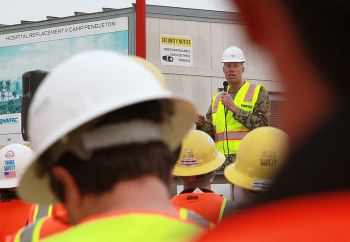People really want to respect their boss. So don't make it hard for them to do it.

In 2011, Google launched Project Oxygen. It was a management undertaking to determine what were the top traits that employees at Google expected of their managers. Up to this point, Google had promoted those with the greatest technical experience into management positions. The conventional thinking was that those who understood the job best, could manage the work the best.
Like many workplaces, the word leadership became interchangeable with management. But you don't have to be in management to be a leader. And you've worked for managers devoid of any leadership capacity. Management has nothing to do with leadership. Safety leadership and safety management are very different.
What Google learned from their employee survey was that out of the Top 8 traits that Google employees expected of their managers, only Number 8 had anything to do with technical expertise. All of the other traits involved people skills.
What Google learned, is a model for what the rest of the world needs to hear; including safety.
In my informal discussions with employees and safety managers/supervisors across North America, I have compiled the top 5 things that employees want from their safety managers, supervisors and the safety program:
1To be cared about. Not because you are legislated by law to look after them. But because you actually care about them, their families and their contribution to the workplace. Employees start to become valuable right after they feel valued. Showing that employees are valued must come first. Otherwise, some employees will become favorites. Others will always be in the doghouse. It's tough to care about your work when it seems no one cares about you.
2To be coached - not hounded. There are two kinds of safety supervisors: those who quote chapter-and-verse from the safety bible and those who put down the manual and take an active interest in helping you to stay safe because they follow Point #1 - to be cared about. If you're following around waiting for them to mess up, they're going to mess up. If you work side-by-side coaching outstanding safety performance, they will give you reasons to be proud. If all you are doing is pencil-whipping forms, you're not engaged with your people. So don't be surprised when they're not engaged with the safety program.
3To not have their time wasted. Safety meetings do this the most. Pencil-whipping checkboxes to cover inspection reports, near-misses, incident findings and number tracking. Meanwhile, employees sit in silence writing nothing down (since there's nothing to remember). No one asks the employees any questions. The employees don't ask any questions of safety personnel. It's a waste of a prime opportunity to build teamwork. Just imagine playing on a professional sports team that didn't communicate with each other. That is not a championship team.
4To have their backs. If you want employees to be accountable for their actions, you have got to support their actions. If you want them to make good decisions, you have got to support their decisions. There isn't a single employee that doesn't feel a bit hesitant and nervous when it comes to refusing unsafe work. When an employee refuses to work any further, support their decision first, then clarify the issue. A momentary stoppage in work is better than shutting down to let the OH&S Officers investigate a major incident.
5To respect their boss. People really want to respect their boss. So don't make it hard for them to do it. Be a coach, not a micro-manager. Get close to your people, don't keep it professional (distant). Engage them in safety meetings, don't lecture them. Stand by your crew and have their backs, don't make them wonder if you do. Know what they do fully. If you have never done the work yourself, get a solid understanding of their work. Have them take you along to learn what they do. Then get out of the office and walk around. Safety people who spend more time in the office than in the field rarely get respected by the workers.
Decent people surround themselves with other decent people. Good management attracts good employees who give good performance. One begets the other. The best places to work are the safest places and those that encourage their people to be engaged.
If you are still convinced that your job as a safety supervisor is only to get compliance, you are a dinosaur. Compliance is the minimum standard you can achieve without breaking the law. Relevant safety people get good performance through caring about the people they work with, having their backs at every turn, coaching them to improve a little each day.
Finding new and unique ways of appealing to employees to embrace safety can prove difficult. Start 2015 the right way. Call Kevin to bring his presentation of personal leadership in safety to your workplace. Kevin’s presentation will support what you’ve been saying to your employees. Kevin will also align with your corporate safety program. Your employees will actually enjoy the safety meeting.



